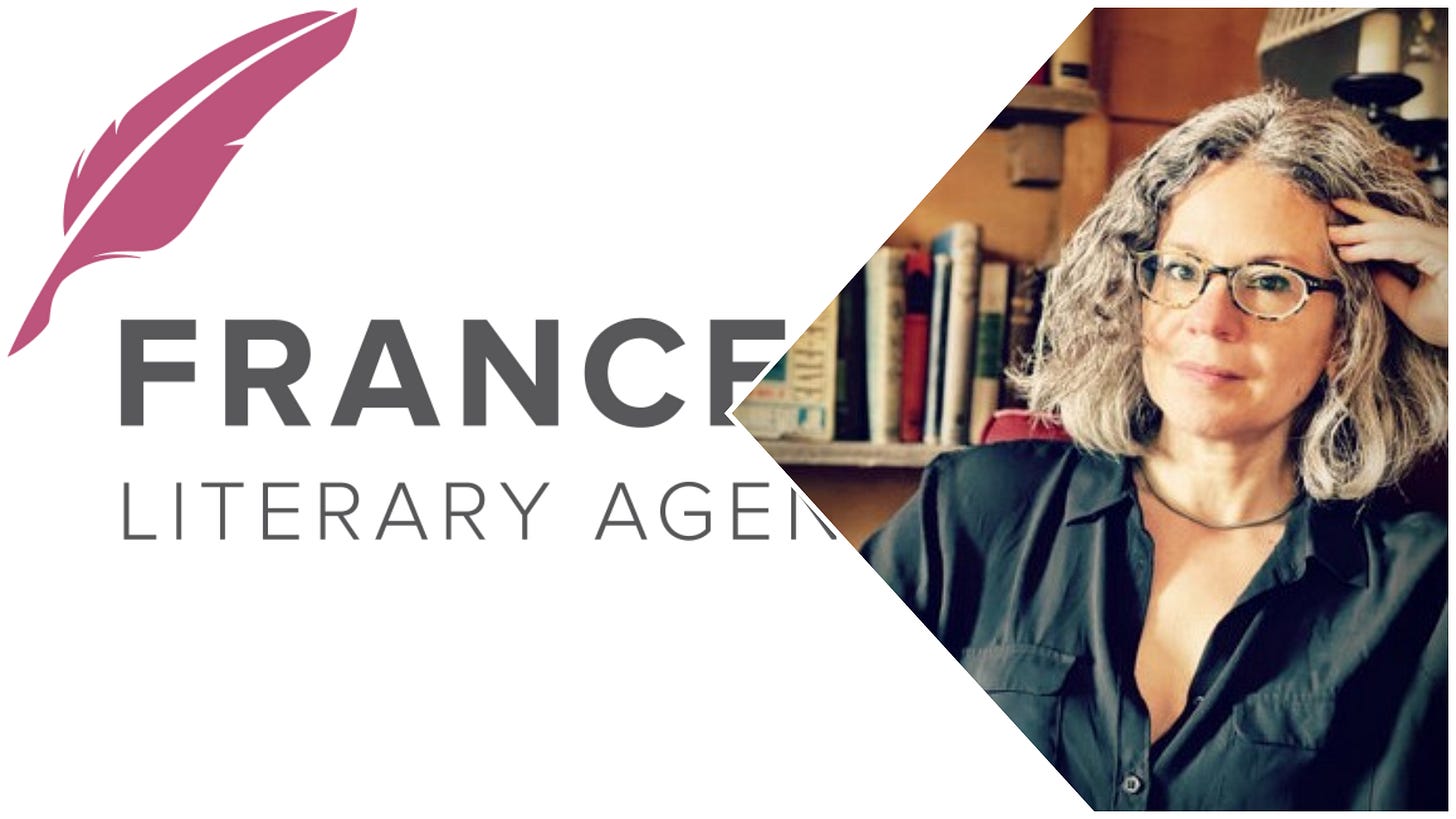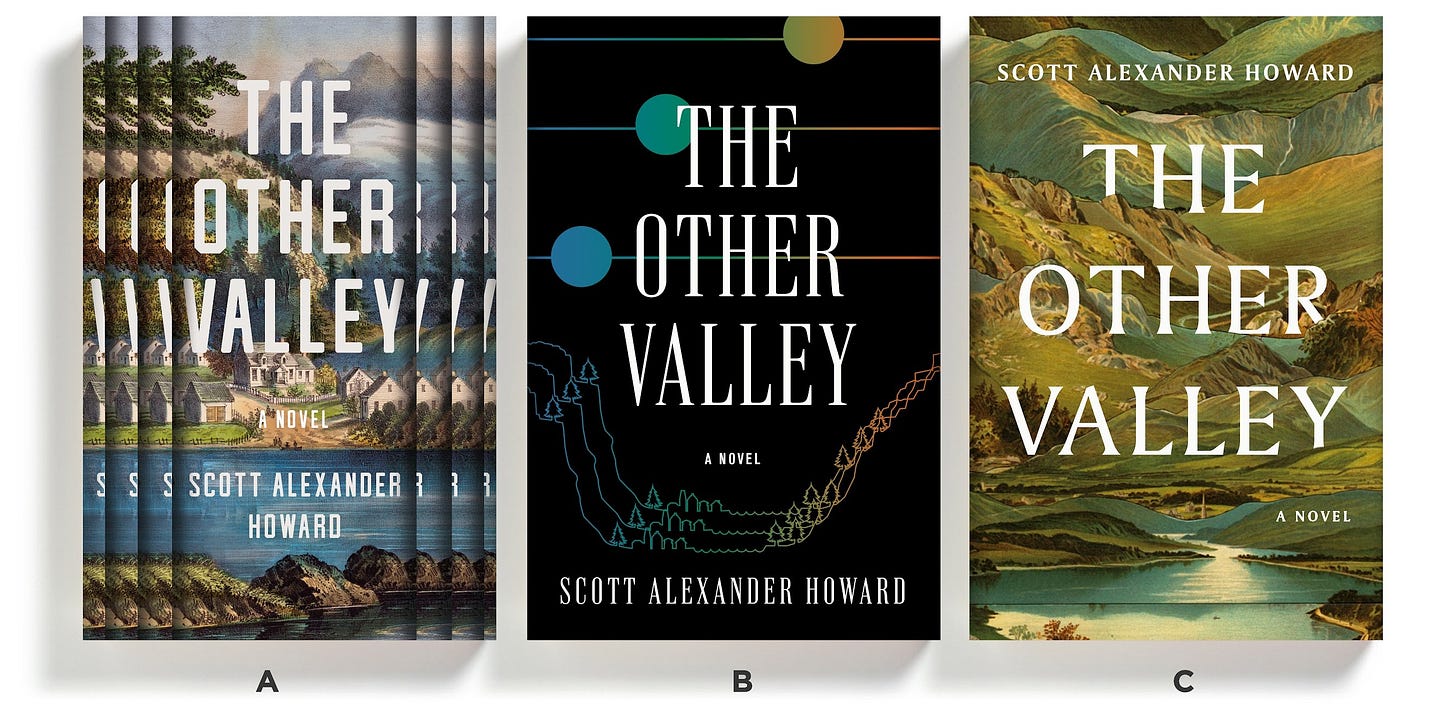Behind the book: A speculative debut destined for TV
"Until your luck changes, you have no way to know if it ever will." Scott Alexander Howard on writing, querying, and submitting THE OTHER VALLEY.
Last week, Deadline reported that the film studio behind this year’s Drive-Away Dolls is developing Scott Alexander Howard’s debut novel, The Other Valley, into a TV series. There’s no network attached yet, but I’m rooting for Apple TV given its success with adaptations of speculative fiction (Silo, Foundation, Shining Girls, The Changeling, The Essex Serpent).
Howard’s premise is irresistible: “Sixteen-year-old Odile is an awkward, quiet girl vying for a coveted seat on the Conseil. If she earns the position, she'll decide who may cross her town's heavily guarded borders. On the other side, it's the same valley, the same town. Except to the east, the town is twenty years ahead in time. To the west, it's twenty years behind. The towns repeat in an endless sequence across the wilderness.”
Howard’s execution is just as stunning: a propulsive, thought-provoking, literary time-travel adventure that reminded me of the Lois Lowry and Ursula K. Le Guin classics I grew up with.
For The Frontlist, I spoke with Howard, his agent Roz Foster, and his cover designer Laywan Kwan about writing, querying, selling, editing, and designing The Other Valley from scratch.
Disclosure: I share a publisher with Howard — Atria Books, an imprint of which is publishing my forthcoming biography of Margaret C. Anderson, A Danger to the Minds of Young Girls.
Scott Alexander Howard, author
When and how did The Other Valley begin for you?
I first got the idea for the world — a place where time travel is ordinary physical travel — during a year when two good friends passed away. As is so often the case, I wasn’t able to say goodbye to them in the way I would have liked. I think that’s why I always saw time travel in this world as being used primarily for mourning. By hiking to a past version of their town, people could see their lost loved ones again.
I had that basic idea for a long time before I decided to try writing a novel. The story took off when I imagined Odile, this solitary girl, recognizing some grieving visitors and being the only one to realize that her classmate is going to die. I liked the tension that foreknowledge created: for the first time in Odile’s life, she has friendship and romance and fledging ambition, but it’s all based on a secret that’s about to upend everything.
What was your querying process like, and why did you choose your agent?
I went into querying without any connections or credentials to recommend me, so all I could do was email my story hook and hope. The process ended up taking five months, which is reasonable in retrospect, but until your luck changes you have no way to know if it ever will.
I was feeling pessimistic in the middle of winter when I suddenly got my first full manuscript requests, two in two days. That was already a huge relief, so it was unbelievable when both led to offers of representation. I had a great conversation with each agent and I decided to go with Roz, whom I’d discovered via the #MSWL hashtag on Twitter — she was requesting submissions that could be comped to Ishiguro.
Before our first meeting, she sent me really insightful notes on the manuscript that showed how deeply she got the book, including observations I’d never thought of. Then, during the meeting, she underscored that she’d want to represent any of my writing, speculative or otherwise. That freedom was important to me.
What was your submission process like, and why did you choose Atria?
The submission process was fast. Roz took the book out on sub on a Thursday, and late that night she had a request for a meeting with Loan Le at Atria. When I met with Loan we clicked, personally and in terms of our vision for the book.
There were other publishers in the mix over the following days, but Roz and I felt that the greatest enthusiasm was coming from Atria, and what mattered to me was that the publisher was truly in love with the book. This was made obvious to us when, not only was Atria amenable to Roz’s request that they improve the offer and countered with a meaningful jump, but they also gladly adhered to her suggestion that, for North American rights, Atria publish the book in the US with a dedicated, US-based PR/marketing team and that S&S Canada publish the book separately in Canada with a dedicated, Canadian-based PR/marketing team.
As a Canadian, it meant a great deal to me that Scribner Canada, their literary imprint, then read with lightning speed and plied us with their own impressive PR/marketing plan. All in all, the whole thing was wrapped up in under two weeks, from taking it to market to saying yes to Atria’s pre-empt. And the choice has paid off: Loan is a magnificent, judicious editor, and everyone at Atria, Scribner Canada, and S&S have been tireless champions of the book.
Roz Foster, literary agent at Frances Goldin
What excited you about Scott’s manuscript?
The writing. It’s exquisite, spare, poetic. The writing was so good in the sample pages, I barely needed to read the details of Scott’s query letter to request the full; however, his background was important, too. I believe Scott’s formal education — a PhD in Philosophy from the University of Toronto — helped him think and write in a way that’s unique from novelists who’ve been molded by more traditional means.
Having studied literature and philosophy myself, my passion for novels was founded on a love for the philosopher poets, like Mann, Dostoevsky, Kafka, Borges, Nabokov, Sartre, de Beauvoir, Camus, Murdoch, Calvino, Philip K. Dick, Le Guin, etc. Their characters are often unmoored in a way I understood at a core level; they’re unmoored in a way that all of us have been, if we’re truly alive and aware.
The protagonist in The Other Valley, Odile, becomes existentially shaken. Her quirky, thoughtful interiority and her particular, consequent path become the opposite of what appears distinct, idiosyncratic. “Odile who stands by herself. Never spoken to and seldom spoken of. Staring at nothing with eyes like carved wood, as motionless as an effigy,” is universally resonant. Her voice and journey are our own.
The teams we spoke with at S&S echoed that sense of connective resonance, as have so many independent booksellers, a startling number of endorsers, and a crowd of early readers. What excited me about Scott’s manuscript is the same ineffably connective stuff that excited them.
What was it originally titled? And did you retitle it for submission?
The original title was Grief Border, which I quite liked. The poetic and market-savvy minds at Atria chose The Other Valley from a list Scott provided, which I also like a great deal. The Other Valley has a subtle, foreboding mystery to it. Combined with Laywan’s stunning cover design, the effect is arresting.
How did (or didn’t!) the manuscript evolve before you submitted it to editors?
The manuscript arrived impossibly clean of errors or awkward phrasing, which could be explained partly by Scott’s having edited philosophical texts professionally for a time. What couldn’t be explained so easily was that the narrative was incredibly tight for a debut. The characters were fully dimensional, never overwritten, with balanced desires and tensions pulling against one another at just the right level of tautness.
Usually, only a much more seasoned novelist is capable of rendering dramatic structure with that level of mastery on the first go. In terms of revision, I only had a few questions, which Scott addressed quickly and beautifully.
Laywan Kwan, associate art director at Atria Books
Our final cover is an iteration of A. I believe B didn’t have the warmth the team was looking for. I can’t remember if there were any comments about C, but I think there was a general consensus that the graphic repetition of the edges in A really reflected the content of the book.
I thought it was important to convey the setting of this book which created the perfect stage to explore the topic of fate vs. free will. It takes place in a valley, but this valley is in between two other valleys that are exactly like it except one is 20 years ahead, and the other is 20 years behind. The same goes for those valleys as well — where there is the same valley next to them that is 20 years beyond. I wanted the cover to feel like a valley amongst other valleys. I thought that repeating the edges of the image would mimic this idea of repetition of place in another time.
The team was very conscientious of using art that would be representative of the author’s intentions. We tried a couple different images of valleys, various renderings of the figures, and some different fonts. Our final cover is what everybody on the team landed on!
Forthcoming in The Frontlist
Behind the book with Rachel Lyon (Fruit of the Dead) and Nathan Ballingrud (The Strange)
April book preview





